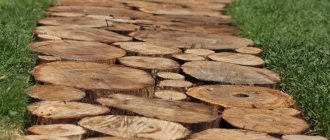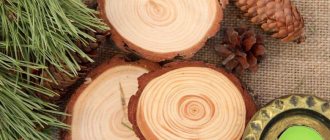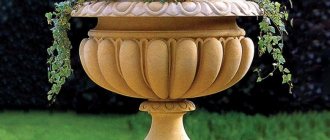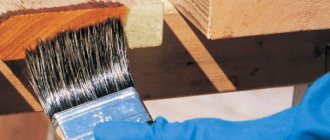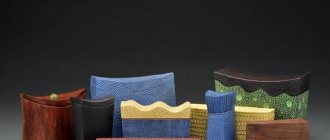Not everyone knows that stain is not just a liquid material, thanks to which wood acquires a brown tone and many of its shades.
Today, wood stains are rich in colors. In addition, it has antiseptic properties, which helps the wood last 2 times longer.
This article will help you get acquainted with modern stain. He will also answer questions about how to make wood stain with your own hands, what types of wood stain exist, and how to paint with wood stain correctly.
Return to content
Functions of stains
Finishes are used to process not only wooden surfaces, but also fiberboard, chipboard, MDF and plywood. Modern compositions, in addition to their main purpose, have disinfecting characteristics and prolong the life of wooden products. Solutions based on alkyds, oils and solvents avoid mold and repel harmful insects.
Sometimes stains are used to hide the real type of wood. Using stain, you can imitate an expensive type of wood (for example, oak) by painting ordinary pine with it. In addition, impregnation can accentuate the natural wood texture. If you use several stains correctly, you can combine a variety of shades into a single artistic design and turn a wooden product into a work of art.
Types of stains
The classification of stains is carried out according to the bases from which the solutions are made. Typically, stains are made using water, alcohol, oil, acrylic or wax. Below we will take a closer look at each of the listed basics.
Water based
Water-based stains are produced in two varieties:
- dry powder for mixing with water;
- ready-to-use aqueous solution.
The main disadvantage of water stains is the long drying period. Therefore, to obtain a uniform surface tone, it takes a lot of time.
When using aqueous compounds, the wood fiber rises. This emphasizes the structure of the material, but makes it less resistant to moisture. To avoid this effect, it is recommended to wet the surface of the wood before impregnation and then sand it well.
Alcohol base
Alcohol-based stains are solutions that include ethyl alcohol, organic dyes and pigments. Such compositions are used not only for decorative surface treatment, but also as antiseptics. As a result of treatment with alcohol solutions, pile raising is reduced and wood swelling does not occur.
Alcohol stains do not allow you to obtain uniformly painted surfaces, since such impregnations dry quickly, which leads to the formation of stains. Thus, alcohol solutions are more applicable to small objects, while for painting large surfaces this is not the best option.
Alcohol stains are applied exclusively using spray bottles. Painting with a brush is not recommended, since it is difficult to achieve high-quality impregnation in this case.
Oil base
Oil-based impregnations allow you to obtain a wide variety of shades. Similar stains are produced based on dyes that dissolve well in oils and drying oils. The solvent element is white spirit.
Working with oil sealant is easy: it can be applied either with a brush or from a sprayer. Such stains do not lift wood fibers and spread evenly over the surface.
Acrylic base
Acrylic-based stains are the latest word in the development of tinting compositions. Thanks to acrylic, a thin colored film appears on the surface. It performs not only decorative, but also protective functions, limiting excessive moisture of the material. Acrylic compounds dry quickly, have no unpleasant odors, are safe and can be used to process any type of wood.
When treating the surface with acrylic paint, you should not get carried away with a large number of layers. As a rule, a couple of layers are enough. If you overdo it, stains will remain on the wooden product.
Wax base
Just like acrylic stains, wax impregnations form decorative and protective films. Typically, such compositions are used together with surface polishing. Wax stain is applied using a soft cloth.
Note! Wax stains should not be used if you plan to treat wood with two-component acid-curing varnishes or polyurethane paints.
What to consider when choosing?
The following factors will help you decide:
- Purpose. There are products for external and internal work, with varying degrees of health safety, covering power and coloring results.
- Additional options. We are talking about protective properties and visual effects: mother of pearl, frost, patina.
- Type of wood. For soft conifers, wax, acrylic and oil stains are preferred, which apply evenly.
- Consumption. It is always indicated on the packaging. If there is a large area to be processed, the issue of economy comes to the fore.
- Color code. It is standard, for example: “walnut”, “cherry”, “mahogany”, but the shades from different manufacturers differ, so it is better to purchase the stain you like with a reserve.
Folk recipes for wood stain production
Making stain can be mastered at home. Compositions can be produced in several ways:
- from plant materials;
- from tea, coffee or vinegar;
- from chemical components.
You can also make a whitening composition. Let's look at the technologies for producing stains with our own hands in more detail below.
Vegetable stains
Below are recipes for plant-based beans:
- Larch bark decoction. Gives the tree a red tint. Birch wood will look especially beautiful.
- The onion peel also gives it a reddish hue. It is customary to treat light wood species with this decoction.
- You can get an impregnation from walnut shells that will give the wood a brown tint. To prepare the impregnation, you need to grind the shells into powder. The dried powder is boiled in water and filtered through a sieve. Next, soda is added to the solution. If you add potassium dichromate to the solution, the wood will get a reddish tint. To obtain a gray tint, acetic acid is applied to the already treated surface.
- Black coloring can be achieved by treating the tree with a decoction of oak and alder bark.
- Also, black color can be obtained by decoction of willow and alder bark.
- A uniform brown color is obtained thanks to a solution to which equal amounts of walnut shells, alder catkins, as well as oak and willow bark are added. The components are poured into water, which is brought to a boil. After this, half a teaspoon of soda is added and the solution is boiled for another 10 minutes.
- A decoction of nut shells and apple tree bark will give the product a brownish tint.
- The wood will acquire a golden hue after treatment with a decoction of buckthorn berries.
Compositions based on tea, coffee and vinegar
- To produce a stain that will give wood a brown color, you should mix ground coffee with soda.
- You can turn light wood brown by brewing tea. The depth of color depends on the strength of the brew.
- The “ebony” effect can be achieved by pouring acetic acid into a container with nails and letting the solution sit for a week in a dark place.
Chemical based formulations
- Oak wood will turn brown if you soak it in slaked lime. The walnut, in addition to its brown color, will acquire a slightly greenish tint.
- Cherry color can be imparted to wood by applying a manganese solution to it. To prepare it, you need to add 50 grams of potassium permanganate to a liter of warm water.
- A yellow color for light wood can be achieved by treating it with a decoction of barberry root. You need to add alum to the prepared broth, and then bring the liquid back to a boiling state.
- A greenish tone can be obtained by mixing 50 grams of copperhead with vinegar. Boil the solution for 15 minutes.
- If you mix wolfberries with vitriol, you get a brown tint. When these same berries are mixed with Glauber's salt, a scarlet color will appear. As a result of mixing wolfberry and soda, a blue tonality is obtained.
Whitening compounds
Bleaching impregnations are used as a preparatory measure before painting wood. Some types of wood get interesting shades as a result of bleaching. For example, the nut with its purple hue takes on a pale pink or scarlet color. Apple wood becomes ivory in color.
Recipes for whitening stains:
- Oxalic acid solution. For 100 grams of water, take 5 grams of acid. The solution is used to bleach light wood. On dark rocks, after treatment with this composition, stains of an unpleasant color will remain. After bleaching, the wood is washed in a solution where 3 grams of soda and 15 grams of lime are taken per 100 grams of water.
- Using a 25% hydrogen peroxide solution, you can bleach almost all types of wood, with the exception of oak and rosewood. In this case, washing is not necessary.
Stain processing methods
Impregnation with stain is possible in several ways:
- Spraying with a spray gun. The method is good because it distributes the composition evenly over the surface.
- Rubbing with a cloth. The method is optimal for porous wood.
- Surface treatment with a roller. Used for application to small areas. When working with a roller, streaks do not occur, and the composition is distributed evenly.
- Application with a brush. This method is not applicable to all types of stains. However, when treated with a brush, wood receives particularly deep shades.
Elimination of defects
Removing stains caused by stain is a complex process.
- Streaks . If the fast-drying material was applied in a thick layer, this problem can be eliminated by removing it as much as possible. To do this, the drying layer is covered with fresh stain. The softened solution is removed with a rag. When the coating is completely dry, solvents are used. Another way to solve this problem is to use a plane or sandpaper.
- Spots . If the coloring is uneven, it will be difficult to cope with. The stained wood is passed through with a plane, and in plywood the top layer will have to be removed. But it is preferable to prevent the formation of spotting: conduct a preliminary surface test, use gel stain or suitable tools.
Taking into account the recommendations given in the article, it will not be difficult to treat surfaces with stain yourself.
Useful tips for masters
Below are tips that will help you achieve better results when treating wood with stain:
- The composition should be applied in the direction of the texture of the material.
- Beitz is applied in 2-3 layers.
- The first layer is to apply a very small amount of solution. You need to wait for the surface to dry. Then it must be sanded and the raised lint removed.
- The brush should not come into contact with areas that have already been treated.
- Wood polishing is carried out in the direction of the grain or obliquely.
- Large surfaces should be divided into sections and treated one at a time.
- A new layer can be applied only after the previous one has dried.
- Compositions based on water or solvent dry up to 3 hours, but oil-based ones - up to 3 days.
- Thick oil stains are diluted with paint thinners, and aqueous compounds are diluted with water.
What it is?
Stain is a liquid product that is applied to a previously prepared wood surface, penetrates into the upper layers and, after drying, changes its color and properties.
The stain consists of a coloring pigment and base, optionally equipped with protective components: against fungi, insects, ultraviolet radiation, humidity, fire. The product was invented in the city of Cologne and throughout the world, including our country, and was originally called “beitz” from the German word for “dye.”
Current beyts can be purchased in the form of a ready-made solution, powder or concentrate for dilution. The higher the concentration, the richer the shade. Application in several layers allows you to enhance the effect, and finishing varnish, oil and wax coatings help to consolidate the result.
Potential problems
If handled incorrectly, drips may occur. This happens when too much stain is applied to the surface. In such a situation, you need to remove as much excess stain as possible. To do this, you need to apply another layer of stain, and then use a rag to remove the excess layer of the compound. A solvent is used to remove dried impregnation. You can also use sandpaper or a plane.
Stains on wood may appear due to uneven density of the material. On some species (for example, walnut), spots do not spoil the appearance, but on coniferous wood or cherry, spotting looks unattractive. Stains can only be removed with a plane. You can prevent the appearance of stains by using gel stains. Such compositions do not spread over the surface and are absorbed for a long time, so the formation of stains is unlikely.
Advantages and disadvantages
The use of stain has positive and negative properties; in order to understand whether this particular material is worth choosing, it is necessary to evaluate each aspect. The advantages of using the composition include:
- A variety of tint types that can give a wooden surface an unusual appearance;
- The grain of the wood is not lost, but rather stands out after processing the stain;
- Water-repellent coating structure;
- Antiseptics are included that protect the tree;
- Affordable cost of the composition.
But there are also disadvantages to these funds; experts note the points described below:
- There are types of stains that raise the fibers of the base, then it is necessary to sand the wood in advance to get a high-quality result without flaws;
- Not every type of stain is capable of creating a barrier from negative factors on a wooden base, and it is necessary to use other compositions;
- A number of products can only be used outside the building, and the master must wear protective gloves, a respirator and clothing;
- Some of the compositions are characterized by quick-drying properties; this requires the master to be able to cope with uniform distribution at a fast pace.
Antiseptics are turned on to protect the wood.

